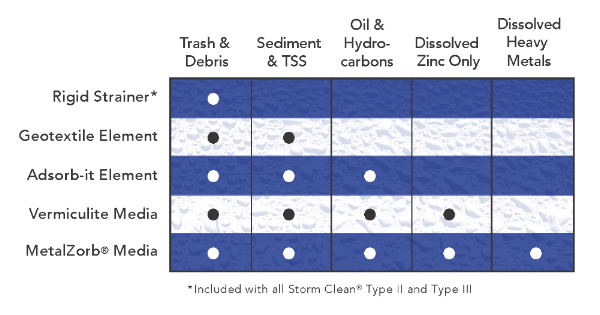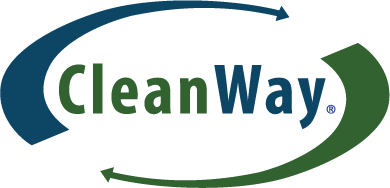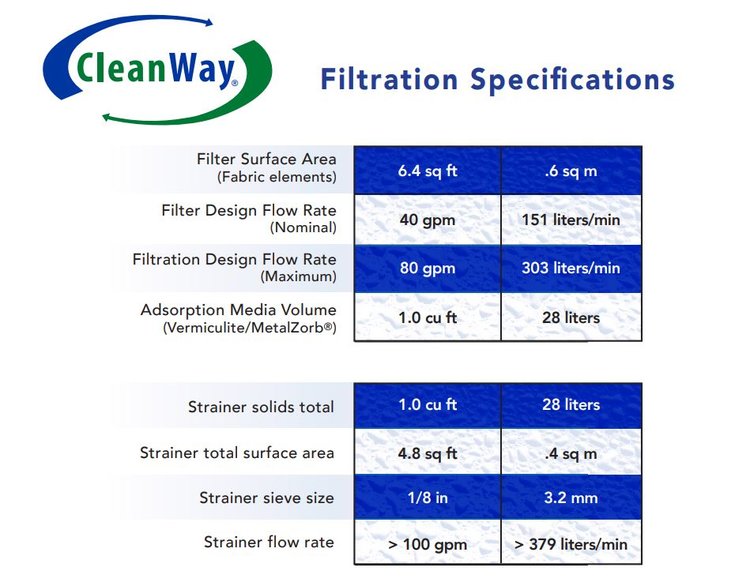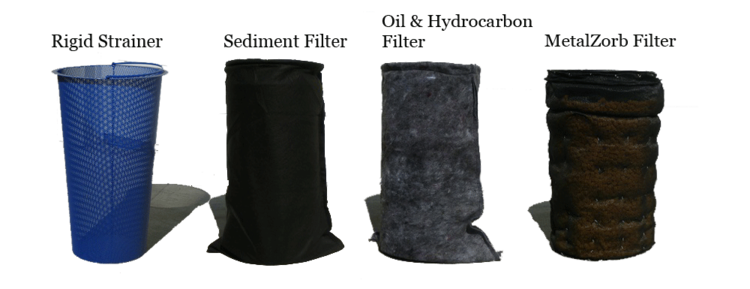
Filter Element Options
CleanWay® Environmental Partners provides a number of stormwater filter elements to help you achieve your water quality goals. Depending on site considerations and target pollutants, CleanWay offers various filtration options with a flexible choice of elements to address the needs at your site.
One of the great benefits of a CleanWay system is not having to change any of the hardware if you want to capture different pollutants or to increase pollutant removal after the unit is installed. This could happen as regulations increase, or as site considerations change over time. You can simply exchange the media during regular maintenance or at any time.
With our adaptive product designs, we can provide filter elements that fit any size catch basin whether round, square or rectangular. Please complete the Client Worksheet for Round or Square / Rectangular basins and we’ll provide a quote.

Catch Basin Drawing with callouts
Client Worksheet for Square or Rectangular Catch Basin
Client Worksheet for Round Catch Basin
Stormwater Industry Terms
CleanWay Product Brief
FILTRATION OPTIONS

Filter Element Options
Filtration Specifications
Request Your Free Quote Today
SELECT FROM A VARIETY OF FILTER ELEMENTS
We manufacture all of our Storm Clean® patented filtration products in the USA.
teel, are powder coated and feature a handle for easy access and cleaning. Our strainers are made with 3/16” openings to meet and exceed California’s 5mm requirement.
Geotextile Elements provide filtration to remove sediment, turbidity, suspended solids and debris. Made from a heat-bonded permeable fabric, they separate and filter pollutants before they enter the downstream flow. Properties: Weight 80. oz/yd2 [g/m2]; Grab Tensile 205 lbs [0.911 kN]; Grab Elongation 50%; Trapezoid Tear 85 lbs [0.378 kN]; CBR Puncture 535 lbs [2.38 kN]; Permittivity 1.35 sec-1; Water Flow 90 gpm/ft2 [3657 1/min/m2]; A.O.S. (Maximum A.R.V) 80 U.S. Sieve [0.180 mm]; U.V. Resistance 70%/500 hrs.
ADsorbit® Filtration Fabric is manufactured from 100% recycled select textile fibers and allows a virtually unrestricted flow of water through the fabric at rates in excess of 100 gallons per minute per square foot. Filter elements retain oils, oil sheen and oilborne contaminants in the fabric matrix and can retain up to 20 times its weight in oils. They are a great solution for removal of oils and hydrocarbons commonly found at industrial and municipal sites.
Installation & Maintenance
Contact Us
Request a Quote
Vermiculite is used in a number of stormwater management systems and designs. Because it can absorb and adsorb a lot of water and also improve drainage capabilities even when holding water, vermiculite is used to hold back water and give it more time to naturally drain away or be filtered. Vermiculite features interesting cation exchange capabilities and is employed when heavy metals pollute storm water and need to be removed before water is discharged downstream. In the white paper Evaluation of media for the adsorption of stormwater pollutants, vermiculite was analyzed along with 7 other media for their adsorption of stormwater pollutants. Of the media tested, the greatest adsorptive capacities of stormwater pollutants were demonstrated in GAC, anthracite and vermiculite. These materials demonstrated good adsorptive capacity for TN and TP (20-60%), and heavy metals (20-100%). While GAC is the best performer, it’s not practical as a passive stormwater filter medium because its particles tend to compact and resist the flow of water to such a degree as to cause pooling and local flooding. Vermiculite is chosen because it has the ability to absorb dissolved heavy metals without leaching, resistance to compaction and high rate of flow.
MetalZorb® is our patented sponge media that effectively absorbs and retains heavy metals so they don’t leach out. MetalZorb efficacy depends on various site considerations including the amount of pollutant to be removed, desired removal efficiency, average size of suspended particles, affinity of the sponge for the targeted pollutant, consistency of the slurry, and the nature of bonding forces which cause the pollutant to be attached to the suspended particles, among others.
Biochar’s incredible porosity and surface area give it a high capacity to adsorb a wide variety of contaminants from water. In many ways, biochar can be thought of as a less expensive version of activated carbon that can be used in many of the same applications. Recent laboratory testing conducted in the Pacific Northwest shows that biochar can effectively reduce contaminants including:
• Heavy metals like zinc, lead, copper, cadmium, cobalt, and nickel
• Totals suspended solids (TSS)
Biochar filtration is an emerging technology that has demonstrated short-term efficacy in pollutant removal from contaminated stormwater, especially for dissolved metals. CleanWay blends Biochar with MetalZorb to target copper and zinc; the blend is often more effective at removing targeted heavy metals than either medium can achieve on its own. The long-term efficacy of biochar is still being evaluated as we have witnessed a variety of results over longer periods of time.


